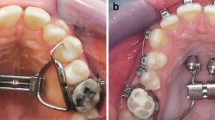Abstract
Introduction
The aim of this study was to compare banded versus modified appliances for anchorage during maxillary protraction in Class III malocclusions.
Patients and methods
The sample size consisted of 40 growing patients with Class III maxillary deficiency: 20 patients received maxillary protraction with a modified appliance and 20 patients with a banded appliance. Pre- and posttreatment cephalometric radiographs of all subjects were obtained and analyzed. The paired t‑test and Wilcoxon ranks test were used for statistical analysis.
Results
The patients in the modified appliance group needed fewer appointments and shorter treatment time than those in the banded appliance group. The modified appliance was superior to the banded appliance with respect to simple structure, comfort, retention, and convenience in maintaining oral hygiene. The modified appliance was as effective as the banded appliance in correcting the Class III malocclusion. However, a greater increase was found in mandibular plane angle, anterior facial height, total facial height, mesialization of maxillary molars, and proclination of maxillary incisors in the banded appliance group compared with that in the modified appliance group (P < 0.05).
Conclusions
The newly developed modified appliance may be a promising approach in treating growing Class III patients with maxillary deficiency, which could decrease treatment time, increase treatment efficiency, and reduce anchorage loss.
Zusammenfassung
Einführung
Ziel der Studie war der Vergleich zwischen der Behandlung mit einer bandgetragenen und einer modifizierten Apparatur zur Verankerung während der Oberkieferprotraktion bei Klasse-III-Malokklusionen.
Patienten und Methoden
Die Stichprobe bestand aus 40 heranwachsenden Patienten mit einem Klasse-III-Maxilladefizit: 20 erhielten eine Maxillaprotraktion mit einer modifizierten Apparatur und 20 mit einer Bandgetragenen Apparatur. Von allen Probanden wurden vor und nach der Behandlung kephalometrische Röntgenaufnahmen angefertigt und analysiert. Zur statistischen Auswertung wurden der gepaarte t‑Test und der Wilcoxon-Rang-Test verwendet.
Ergebnisse
Die Patienten in der Gruppe mit der modifizierten Apparatur benötigten weniger Termine und kürzere Behandlungszeiten als die Patientengruppe mit der Bandapparatur. Die modifizierte Apparatur war der Bandapparatur überlegen im Hinblick auf einfachen Aufbau, Verträglichkeit, Retention und Komfort bei der Aufrechterhaltung der Mundhygiene. Die modifizierte Apparatur war bei der Korrektur der Klasse-III-Malokklusion ebenso effektiv wie die Bandapparatur. Allerdings zeigte sich in der Bandapparaturgruppe eine vergleichsweise größere Zunahme des Winkels der Unterkieferebene, der anterioren und der gesamten Gesichtshöhe, der Mesialisierung der oberen Molaren und der Proklination der oberen Schneidezähne (p < 0,05).
Schlussfolgerungen
Die neu entwickelte modifizierte Apparatur könnte ein vielversprechender Ansatz zur Behandlung von noch wachsenden Klasse-III-Patienten mit einem Oberkieferdefizit sein. Sie könnte die Behandlungszeit verkürzen, die Behandlungseffizienz erhöhen und den Verankerungsverlust reduzieren.










Similar content being viewed by others
References
Molina-Berlanga N, Llopis-Perez J, Flores-Mir C, Puigdollers A (2013) Lower incisor dentoalveolar compensation and symphysis dimensions among class I and III malocclusion patients with different facial vertical skeletal patterns. Angle Orthod 83:948–955
Ellis EE, McNamara JA (1984) Components of adult Class III malocclusion. Am J Orthod Dentofacial Orthop 85:277–290
Suda N, Ishii-Suzuki M, Hirose K, Hiyama S, Suzuki S, Kuroda T (2000) Effective treatment plan for maxillary protraction: is the bone age useful to determine the treatment plan? Am J Orthod Dentofacial Orthop 118:56–62
Kajiyama K, Murakami T, Suzuki A (2000) Evaluation of the modified maxillary protractor applied to class III malocclusion with retruded maxilla in early mixed dentition. Am J Orthod Dentofacial Orthop 118:549–559
Sar C, Arman-Özçirpici A, Uçkan S, Yazici AC (2011) Comparative evaluationof maxillary protraction with or without skeletal anchorage. Am J Orthod Dentofacial Orthop 139:636–649
Elnagar MH, Elshourbagy E, Ghobashy S, Khedr M, Evans CA (2016) Comparative evaluation of 2 skeletallyanchored maxillary protraction protocols. Am J Orthod Dentofacial Orthop 150:751–762
Atalay Z, Tortop T (2010) Dentofacial effects of a modified tandem traction bow appliance. Eur J Orthod 32:655–661
Ngan P, Cheung E, Wei SHY (2007) Comparison of protraction facemask response using banded and bonded expansion appliances as anchorage. Semin Orthod 13:175–185
Shrestha S, Sharma AK, Lamichhane B (2016) Oral health status in patients with fixed orthodontic appliance with molar bands and bonded tubes. Orthod J Nepal 1:27–31
Liu W, Zhou Y, Wang X, Liu D, Zhou S (2015) Effect of maxillary protraction with alternating rapid palatal expansion and constriction vsexpansion alone in maxillary retrusive patients: a single-center, randomized controlled trial. Am J Orthod Dentofacial Orthop 148:641–651
Wang YC, Chang PMS, Liou EJW (2009) Opening of circumaxillary sutures by alternate rapid maxillary expansions and constrictions. Angle Orthod 79:230–234
Tortop T, Keykubat A, Yukse S (2007) Facemask therapy with and without expansion. Am J Orthod Dentofacial Orthop 132:467–474
Vaugh GA, Mason B, Moon HB, Turley PK (2005) The effects of maxillary protraction therapy with or without rapid palatal expansion: a prospective, randomized clinical trial. Am J Orthod Dentofacial Orthop 128:299–309
Yoshida I, Shoji T, Mizoguchi I (2007) Effects of treatment with a combined maxillary protraction and chincap appliance in skeletal class III patients with different vertical skeletal morphologies. Eur J Orthod 29:126–133
Cozza P, Marino A, Mucedero M (2004) An orthopaedic approach to the treatment of class III malocclusions in the early mixed dentition. Eur J Orthod 26:191–199
Kircelli BH, Pektas ZO (2008) Midfacial protraction with skeletally anchored face mask therapy: a novel approach and preliminary results. Am J Orthod Dentofacial Orthop 133:440–449
Kilic N, Catal G, Kiki A, Oktay H (2010) Soft tissue profile changes following maxillary protraction in class III subjects. Eur J Orthod 32:419–424
Mouakeh M (2001) Cephalometric evaluation of craniofacial pattern of Syrian children with class III malocclusion. Am J Orthod Dentofacial Orthop 119:640–649
Author information
Authors and Affiliations
Corresponding author
Ethics declarations
Conflict of interest
C. Liu, X. Qiao, S. Zhang, W. Ma, W. Wang, X. Ge, X. Hu, W. Kang and H. Lu declare that they have no competing interests.
Ethical standards
This study was approved by the Ethics Committee of Stomatological Hospital of Hebei Medical University No. [2014] 005.
Rights and permissions
About this article
Cite this article
Liu, C., Qiao, X., Zhang, S. et al. Banded versus modified appliances for anchorage during maxillary protraction. J Orofac Orthop 81, 172–182 (2020). https://doi.org/10.1007/s00056-019-00214-5
Received:
Accepted:
Published:
Issue Date:
DOI: https://doi.org/10.1007/s00056-019-00214-5




